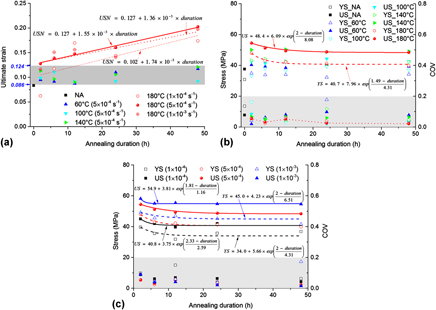Crossref Citations
This article has been cited by the following publications. This list is generated based on data provided by
Crossref.
Long, Xu
Tang, Wenbin
Xu, Mengfei
Keer, Leon M.
and
Yao, Yao
2018.
Electric current-assisted creep behaviour of Sn–3.0Ag–0.5Cu solder.
Journal of Materials Science,
Vol. 53,
Issue. 8,
p.
6219.
Long, Xu
Zhang, Xiaodi
Tang, Wenbin
Wang, Shaobin
Feng, Yihui
and
Chang, Chao
2018.
Calibration of a Constitutive Model from Tension and Nanoindentation for Lead-Free Solder.
Micromachines,
Vol. 9,
Issue. 11,
p.
608.
Tang, Wenbin
Long, Xu
Liu, Yongchao
Du, Chongyang
Yao, Yao
Zhou, Cheng
Wu, Yanpei
and
Jia, Fengrui
2018.
Effect of Electric Current on Constitutive Behaviour and Microstructure of SAC305 Solder Joint.
p.
717.
Wang, Wenjie
Yao, Yao
Long, Xu
and
Zhu, Zhenghu
2018.
Material and structural optimization of fatigue life of PBGA under temperature cycling.
p.
477.
Long, Xu
Tang, Wenbin
Wang, Shaobin
He, Xu
and
Yao, Yao
2018.
Annealing effect to constitutive behavior of Sn–3.0Ag–0.5Cu solder.
Journal of Materials Science: Materials in Electronics,
Vol. 29,
Issue. 9,
p.
7177.
Long, Xu
Du, Chongyang
Hu, Bo
and
Li, Mingyu
2018.
Comparison of sintered silver micro and nano particles: from microstructure to property.
p.
1.
Wang, Wenjie
and
Long, Xu
2019.
Temperature and strain-rate dependent constitutive model for prediction of thermal cycling life.
IOP Conference Series: Materials Science and Engineering,
Vol. 531,
Issue. 1,
p.
012036.
Wang, W. J.
Long, X.
Du, C. Y.
Fu, Y. H.
Yao, Y.
and
Wu, Y. P.
2019.
Enhancement of the Unified Constitutive Model for Viscoplastic Solders in Wide Strain Rate and Temperature Ranges.
Strength of Materials,
Vol. 51,
Issue. 6,
p.
917.
Hammad, A.E.
and
Ragab, M.
2020.
Achieving microstructure refinement and superior mechanical performance of Sn-2.0Ag-0.5Cu-2.0Zn (SACZ) solder alloy with rotary magnetic field.
Microelectronics Reliability,
Vol. 113,
Issue. ,
p.
113932.
Long, Xu
Chen, Zubin
Wang, Wenjie
Fu, Yonghui
and
Wu, Yanpei
2020.
Parameterized Anand constitutive model under a wide range of temperature and strain rate: experimental and theoretical studies.
Journal of Materials Science,
Vol. 55,
Issue. 24,
p.
10811.
Salita, D. S.
and
Polyakov, V. V.
2020.
Acoustic Emission during Plastic Deformation of Pb–Sn
Alloys.
Physical Mesomechanics,
Vol. 23,
Issue. 6,
p.
593.
Liang, Tong
Yuan, Weike
and
Wang, Gangfeng
2021.
Influence of Equi-Biaxial Residual Stress on Spherical Indentation of Strain Hardening Materials.
International Journal of Applied Mechanics,
Vol. 13,
Issue. 05,
Yang, Yang
Xu, Tianyu
Guo, Junli
He, Zheng
and
Ma, Houbiao
2021.
Strength reserve assessment on pitting-corroded jacket offshore platforms based on the modified generalized constitutive model.
Thin-Walled Structures,
Vol. 169,
Issue. ,
p.
108494.
Sobolewski, Maciej
Wojewoda-Budka, Joanna
Huber, Zbigniew
Zieba, Pawel
and
Wierzbicka-Miernik, Anna
2021.
Solder joints reliability of through hole assemblies with various land and hole design.
Microelectronics Reliability,
Vol. 125,
Issue. ,
p.
114368.
Tynchenko, Vadim
Kurashkin, Sergei
Tynchenko, Valeriya
Bukhtoyarov, Vladimir
Kukartsev, Vladislav
Sergienko, Roman
Kukartsev, Viktor
and
Bashmur, Kirill
2021.
Mathematical Modeling of Induction Heating of Waveguide Path Assemblies during Induction Soldering.
Metals,
Vol. 11,
Issue. 5,
p.
697.
Salita, D. S.
and
Polyakov, V. V.
2022.
Violation of Kaiser effect in Pb–Sn alloys.
Vol. 2509,
Issue. ,
p.
020164.
Long, Xu
Li, Jiao
Shen, Ziyi
and
Su, Yutai
2022.
Dimensionless Analysis to Determine Elastoplastic Properties of Thin Films by Indentation.
Coatings,
Vol. 12,
Issue. 11,
p.
1768.
An, Qi
An, Rong
and
Wang, Chunqing
2022.
Interfacial Endogenous Stress-Induced Phase-Stress Partition in Tin-Lead Dual-Phase Alloy at Cryogenic Temperature.
SSRN Electronic Journal ,
Long, Xu
Dong, Ruipeng
Su, Yutai
and
Chang, Chao
2023.
Critical Review of Nanoindentation-Based Numerical Methods for Evaluating Elastoplastic Material Properties.
Coatings,
Vol. 13,
Issue. 8,
p.
1334.
Cong, Sen
Liu, Peng
Wang, Shaobin
and
Xiong, Jinghua
2023.
Reliability and prediction of Sn36Pb2Ag solder joints under thermal aging test.
Materials Research Express,
Vol. 10,
Issue. 4,
p.
046301.
